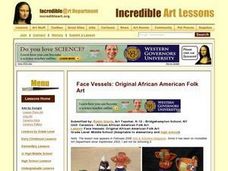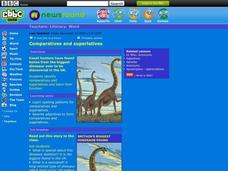Curated OER
Ceramics - African African American Folk Art
Students gain appreciation and knowledge of art history, specifically the African American contributions to folk art made in the South Carolina region.
Curated OER
The South Wins Gettysburg!
High schoolers explore American Civil War, hypothesize that the Union Army was defeated at Gettysburg by Lee's army, and write an essay describing how different North America would be today if the South had won the Civil War.
Curated OER
African Americans in the Maritime Trades
Learners explore Civil Rights by analyzing U.S. history. In this African American workforce lesson plan, students discuss the history of African Americans in Baltimore and the need for steady work that formed. Learners define vocabulary...
Curated OER
The Buffalo: A Way of Life for the Plains Indians
Eighth graders complete a KWL chart on the Plains Indians. After watching a video, they state the difference between legends and facts about the importance of the buffalo to Native Americans. They also practice their note-taking skills...
Mr. Nussbaum
Fort Sumter Reading Comprehension
The Battle of Fort Sumter was both the first and the least deadly battle of the American Civil War, with no soldiers lost during the lengthy bombardment. Learn more about the first shots of the Civil War with a short reading passage and...
Curated OER
A Bird's Eye View of the Caribbean: Art, Folklore, and Music
Students examine the Caribbean in terms of its music, art, and folklore. As a class, they listen to a folktale and discuss the difference between telling a story and reading a story. In groups, they write their own folktale and share...
Curated OER
Why Is North Korea Going At It Alone?
High schoolers examine the division of North and South Korea. They identify the ideological differences and the tensions between the two countries. They discuss the threat of nuclear weapons as well.
Curated OER
Community Symbols: Heroes and Leaders
Students research the importance of community leaders in portraits. In this art history lesson, students look at the painting "The Ascension of Simon Bolivar on Mount Jamaica" and discuss what they see in the portrait. Students research...
Benjamin Franklin Tercentenary
Learning the Printing Trade
Students explore U.S. History by reading biographical text in class. In this Benjamin Franklin instructional activity, students read about the famous American's first job and the transition he underwent from printing to politics....
Curated OER
Comparatives and superlatives
Students identify comparatives and superlatives. Students read article on comparatives and superlatives. They explore spelling patterns. Students rewite adjectives to form comparatives and superlatives and complete a worksheet.
Curated OER
CLOTHESLINE SLEUTH
Pupils will trace origins of various forms of clothing to their agricultural sources.String a cotton cord across the top of a blackboard to resemble a clothesline. 2. Bring a variety of clothing articles to class made from a variety of...
Curated OER
Colored Pencil Repoussé
Artists employ a basic metalworking technique by embossing lines and textures into a soft metal. They look for examples of embossed metals in historical and contemporary examples. This fascinating process has been used by many cultures...
Curated OER
William Faulkner's "The Sound and the Fury": Narrating the Compson Family Decline and the Changing South
Students read "The Sound and the Fury" and consider the changing narrative structure and voice throughout the novel. They trace the decline of the Compson family.
Curated OER
Imagen e ldentidad/Image and Identity: Multiple Voices, Violations and Victories
Students spend a year involved in a project researching the diversity of Native Americans.
Curated OER
Jamestown Journey Part 1
Fourth graders work to solve one of the major problems facing the Jamestown settlers, the best location to settle upon arrival in Jamestown. Students discuss and review the past European and American events that lead to the...
National Endowment for the Humanities
Character in Place: Eudora Welty’s “A Worn Path” for the Common Core
How do writers use the interaction between elements like characterization and setting to create meaning? Readers of "A Worn Path" create a series of comic book-style graphics of Eudora Welty's short story and reflect on how Welty...
West Jefferson High School
The Novel — Honor
For classes tackling To Kill a Mockingbird, this lesson plan sets readers up for discussions or essay writing with questions and prompts. The prompts encourage individuals to explore beyond the novel itself, looking at...
ProCon
Milk
Milk: It does a body good ... or does it? Using the provided website, scholars sort through information to answer the question. They review a chart demonstrating lactose intolerance by ethnicity and region, and they also compare the...
Curated OER
Revolutionary Money
Examine paper money from the American revolution! Historians study the paper bills and discuss the history of money. How has money changed over the times? Activities are included.
Curated OER
Genealogy Research
Pupils explore history is not as a listing of dates, wars, and leaders but as the story of real people whose lives were impacted by the events of their time. They complete a pedigree chart and tape record a family member.
Curated OER
Piece by Piece
Learners study quilts. In this history/geometry quilt lesson, students discover the history behind quilt making and get a chance to make quilt blocks of their own. They work independently to make a quilt block out of construction paper...
CHPCS
The United States in the 1920s: The New Negro Movement and the Harlem Renaissance
Music, writing, and activism all tell the story of history! The resource uses these elements and more in a presentation to discuss the Jazz Age and Harlem Renaissance. Your class views biographies, discusses important events, and...
New York State Department of Environmental Conservation
Adaptations – Designs for Survival
What's the difference between behavioral adaptations and physical adaptations? Learn about the various ways that organisms adapt to their environment with a worksheet about the creatures of the Hudson River.
Curated OER
Coiling Geography "On the Pampas"
First graders are introduced to the rope coiling form of art used by the gaucho culture of South America. They read "On the Pampas" by Maria Cristina Brusca, view the illustrations of the coiling technique and create original pieces.

























